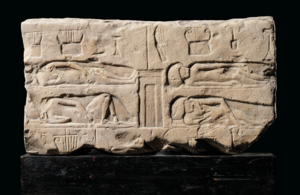Ancient Egyptian limestone relief of female musicians at risk of leaving UK
Export bar placed on the relief to allow time for a UK institution to acquire the work

- The relief depicts a group of female musicians asleep in the palace of the pharaoh Akhenaten
A limestone relief that offers an insight into daily Egyptian life more than 3,300 years ago is at risk of leaving the UK unless a domestic buyer can be found.
The artwork depicts a group of female musicians asleep in the palace of the ancient Egyptian pharaoh Akhenaten. It was created at some point during his 17-year reign from 1351 to 1334 BC.
The relief could be very valuable to historians studying this period of history. It is highly unusual in depicting women as musicians and by making them the focus of attention, unlike other, more marginal, depictions. It also offers an insight into life in the palace at the time away from the king and queen.
There are also very few reliefs from this period that have survived in such a large piece, with four figures depicted on the same fragment of stone.
Arts and Heritage Minister Lord Parkinson of Whitley Bay said:
This limestone relief offers a beguiling glimpse into daily life in the Amarna Period of Ancient Egypt and is hugely valuable to academics researching this fascinating period of history.
I hope a UK buyer can come forward so this important artefact can be enjoyed and studied here by future generations, for the benefit of people all over the world.
The minister’s decision follows the advice of the Reviewing Committee on the Export of Works of Art and Objects of Cultural Interest.
Committee Member Pippa Shirley said:
This ancient object speaks to us with extraordinary clarity across thousands of years. It shows an instantly recognizable subject – a group of women asleep. They are musicians, and we see them in wholly natural, individual poses, lying on mats with sheets drawn up around them, with their instruments (harps, lutes and box lyres) close at hand, and a brazier in each room to keep them warm.
They are part of the entourage of the fabled pharaoh, Akhenaten and his equally famous queen, Nefertiti, and are depicted with great care by the sculptor in their palace quarters. Glimpses of the private lives of servants from this period are immensely rare, and this one, in the revolutionary style developed by Akhenaten for the palaces and temples at his new capital city, Amarna, is unparalleled. The King and Queen oversaw the design and execution of the decorative schemes, and encouraged not only greater artistic freedom and naturalistic composition, but a growing interest in reflecting the lives of ordinary people. Although only a fragment, the light the relief casts on aspects of art, culture and daily life during the reign of one of the most intriguing rulers of Ancient Egypt means that every effort should be made to keep it in this country.
The committee made its recommendation on the basis the relief meets the second and third Waverley criteria for its outstanding contribution to the study of Amarna period, Egyptology, art history and early human societies.
The decision on the export licence application for the relief will be deferred for a period ending on 22 April 2023. At the end of the first deferral period owners will have a consideration period of 15 Business Days to consider any offer(s) to purchase the relief at the recommended price of £69,300 (plus VAT of £2,860 which can be reclaimed by an eligible institution). The second deferral period will commence following the signing of an Option Agreement and will last for three months.
ENDS
Notes to editors:
-
Last month Lord Parkinson discussed the Waverley criteria in a speech to mark their 70th anniversary, and used the opportunity to invite thoughts on the way they work – for instance, whether the Committee should say more about how it has considered items’ connection to the history of other countries as well as to the UK’s, or whether the items it considers are destined for public display rather than private collection. His full speech can be found at: https://www.gov.uk/government/speeches/lord-parkinson-speech-at-a-reception-to-mark-70-years-of-the-waverley-criteria
-
Organisations or individuals interested in purchasing the sculpture should contact the RCEWA on 0161 934 4317.
- Details of the relief are as follows: 40cm long
- Provenance: Margret Burg (1894-1957), London; and thence by descent to the present owner.
- The Reviewing Committee on the Export of Works of Art and Objects of Cultural Interest is an independent body, serviced by Arts Council England (ACE), which advises the Secretary of State for Digital, Culture, Media and Sport on whether a cultural object, intended for export, is of national importance under specified criteria.
- Arts Council England is the national development agency for creativity and culture. Its strategic vision in Let’s Create is that, by 2030, England should be a country in which the creativity of everyone is valued and given the chance to flourish and where everyone has access to a remarkable range of high-quality cultural experiences. ACE invests public money from the government and the National Lottery to support the sector and deliver the vision. Following the Covid-19 crisis, ACE developed a £160 million Emergency Response Package, with nearly 90 per cent coming from the National Lottery, for organisations and individuals needing support. It is also one of the bodies administering the government’s unprecedented Culture Recovery Fund.